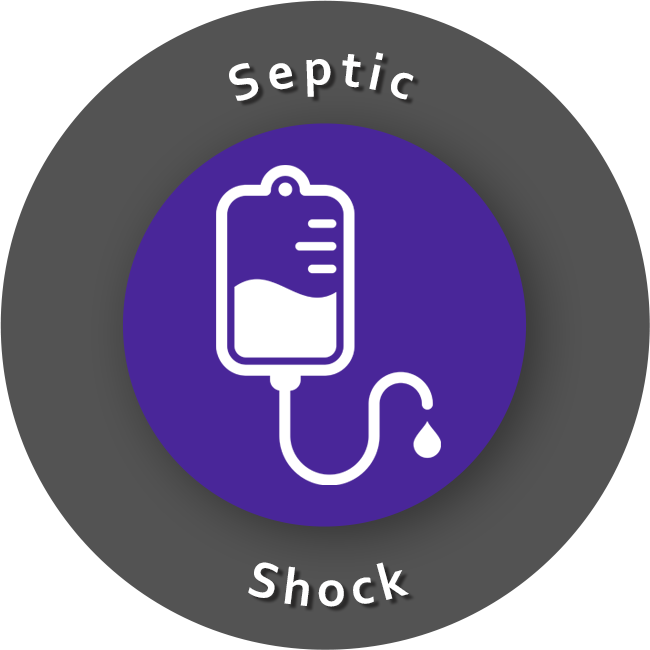
Septic Shock Overview
The most prevalent form of distributive shock in children is septic shock. Common locations in the body where infections that lead to septic shock occur are the chest, abdomen, and genitourinary tract.
Septic shock typically occurs when pathogenic microorganisms and their byproducts (endotoxins) trigger a systemic inflammatory response in the body.
This inflammatory response progresses on a continuum as follows:
systemic inflammatory response (SIRS) → sepsis → severe sepsis → septic shock.
The inflammatory phase of sepsis causes the production and release of inflammatory mediators called cytokines. Cytokines cause endothelial injury, increased capillary permeability, and profound vasodilation. The cytokines may also activate the coagulation cascade which causes systemic microclotting and can ultimately result in disseminated intravascular coagulation (DIC).
It is the combination of microorganism-produced endotoxins and the negative effects of the cytokines that cause the progression of the systemic inflammatory response toward septic shock.
As with all forms of shock, the problem lies in the fact that adequate oxygen and nutrient delivery to the organs and tissues of the body is compromised. Specifically with septic shock, this is caused by relative hypovolemia, vasodilation, and decreased systemic vascular resistance (SVR).
All aspects of stroke volume can be compromised by the systemic inflammatory response that occurs with sepsis. In other words, preload, afterload, and contractility can all be negatively affected by the systemic inflammatory response that occurs with sepsis.
Shock can be divided into two specific phases. The first is WARM SHOCK which occurs early, is compensated, and is hyperdynamic. The second is COLD SHOCK which occurs late and is uncompensated with decreased cardiac output.
Warm Shock:
Warm shock occurs as a result of compounds produced during the inflammatory response. The primary compounds released include histamine, bradykinins, serotonin, and endorphins. The major effects are increased heart rate, vasodilation, low peripheral vascular resistance, and possibly low BP or widening pulse pressure.
These compounds also make capillaries more permeable, causing leakage and fluid shifting out of the cardiovascular system. The patient in this stage will be relatively warm and flushed, hence the name warm shock.
Cold Shock:
As shock progresses and the body’s compensatory mechanisms to maintain cardiac output fail, the ominous late stage of cold shock occurs. This late stage has similar symptoms to terminal hypovolemic shock, and hypo-perfusion leads to profound hypotension.
Early detection and treatment of sepsis or warm septic shock should be the goal. The earlier that sepsis/septic shock is recognized and treated, the better the patient outcome.
Recognition of Septic Shock:
Signs and Symptoms:
In children, the compensatory mechanisms that maintain cardiac output are extremely efficient and there is generally a stable blood pressure until decompensation occurs.
In spite of this extreme efficiency, there are subtle signs and symptoms that can be clues that sepsis is progressing to shock.
As discussed in the Introduction to Pediatric Shock, cardiac output = stroke volume (preload, afterload, and contractility) x heart rate. (CO = SV x HR)
In children, the most effective and sensitive way to identify shock is by careful and repeated physical exam. Signs and symptoms will occur as a result of poor perfusion, inadequate oxygen delivery, and compensatory mechanisms that attempt to alter heart rate, preload, afterload, and contractility.
In children, clinical signs are better indicators of shock than hypotension. Do not rely on the presence of hypotension as an indicator of sepsis or septic shock. The following list provides early and late signs and symptoms using the primary assessment model (ABCDE).
- Airway:
- typically no significant signs and symptoms involving airway
- Breathing:
- increased respiratory rate (compensation for metabolic acidosis)
- may be an increased work of breathing if the patient is developing ARDS
- Circulatory:
- tachycardia (earliest sign)
- bounding peripheral pulses (warm shock)
- flash capillary refill (warm shock)
- widening pulse pressure (warm shock)
- capillary refill > two seconds (cold shock)
- mottled, cool extremities (cold shock)
- Decreased urine output (caused by poor circulatory perfusion)
(less than 1 ml/kg/hr is oliguria) - narrowing pulse pressure (cold shock)
- Disability:
- mental status changes occur as shock progresses
- restlessness → agitation → anxiousness → decreased mental status (warm and cold shock)
- Exposure:
- petechial rash (result of meningococcemia or DIC)
- hyperthermia (warm shock)
- warm, flushed skin (warm shock)
- hypothermia (cold shock)
- cool, mottled extremities (cold shock)
Safwan says
Need treatment